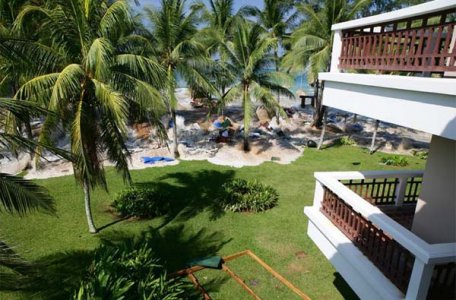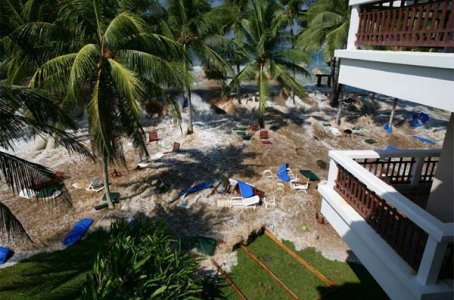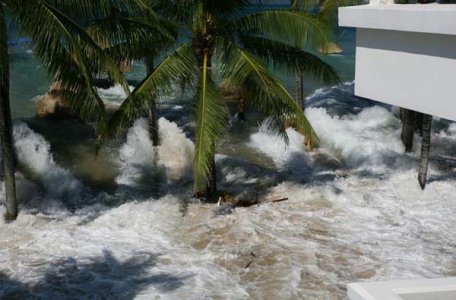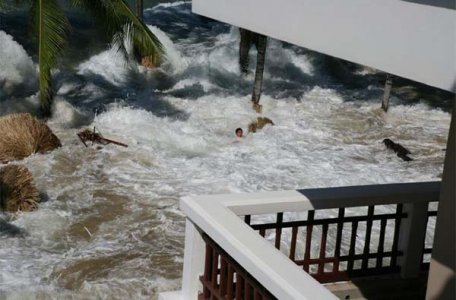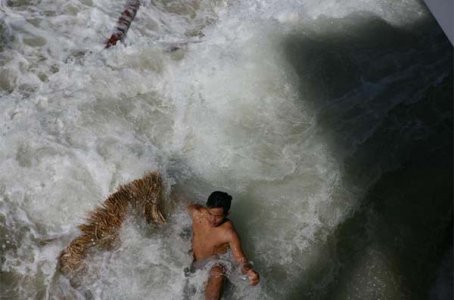You are using an out of date browser. It may not display this or other websites correctly.
You should upgrade or use an alternative browser.
You should upgrade or use an alternative browser.
Tsunami Pictures
- Thread starter MiamieNeSeX
- Start date
What is even more amazing is that it travelled at 500mph.
I think you need a little more boost Armando. :biggrin:
I think you need a little more boost Armando. :biggrin:
Or slap some pontoons and a rudder on the NSX
Armando
Armando
Wow, great pics. Where did you get them? I haven't seen anything as good in the media.
Do you know where those were taken? I lived and worked there for a number of years, helping to open several of the resorts in Phuket and one in the Maldives. From what I've heard they all escaped with relatively little property damage but many others were not so fortunate. Of course it goes without saying that the real tragedy is the death of so many people. Like many catastrophes it will be the worst for the hard working poor.
Do you know where those were taken? I lived and worked there for a number of years, helping to open several of the resorts in Phuket and one in the Maldives. From what I've heard they all escaped with relatively little property damage but many others were not so fortunate. Of course it goes without saying that the real tragedy is the death of so many people. Like many catastrophes it will be the worst for the hard working poor.
A buddy sent them to me and he got them from a website. Tragic and amazing at the same time.
Armando
Armando
During major tidal wave/tsunami events, the sea will suck out immediately preceeding the surge in water. Accordingly, there were survivor reports of the sea sucking out by about 1/2 mile in spots right before the tsunami waves hit. It would be very interesting to see video of this phenomenon.
I am sure in this day and age with everyone walking around either with a digital camera or camcorder that there are a few such videos floating around.
Armando
Armando
Incredibly video on CNN
Armando
Armando
MiamieNeSeX said:I am sure in this day and age with everyone walking around either with a digital camera or camcorder that there are a few such videos floating around.
Armando
there are likely many more..but with the large portions of communications networks in the areas down, it's likely difficult for people to get to upload and send all the videos/pics that have been captured.
Most news agencies are getting reports from the few people that have tracked down cell phones and sattelite phones that are actually working
MiamieNeSeX said:I am sure in this day and age with everyone walking around either with a digital camera or camcorder that there are a few such videos floating around. Armando
Floating around? Nice pun. :wink:
DocL said:What is even more amazing is that it travelled at 500mph.
500 MPH or 500 miles??
92NSX said:500 MPH or 500 miles??
500MPH... they said here 800kph. Amazing.
Then why did it take hours to reach land?NetViper said:500MPH... they said here 800kph. Amazing.
Then why did it take hours to reach land?
Because some of the land, such as Sri Lanka were hundreds of kilometers away from the epicenter of the quake, which was off the coast of Thailand I believe. Also, I believe that the speed is not as great in the water, and it's only when it reaches near shore that it hits resistance and the waves compress and increase in energy, which causes the waves to reach their incredible height and speed.
I'm not doubting the speed at which they can travel. Anyone can google "Tsunami" and see that a speed of 500 mph is quite possible. I guess what I'm having trouble with is that I read that the wall of destruction took something like 4 hours to hit Phuket. And Phuket is not 2500 miles away. Maybe the story had their time-line miss-stated or something (can't find it now). BTW, if Sri Lanka were a few hundred miles away, then traveling at an average speed of 450 mph would take it only ~20 minutes.
BTW, nice pics, Armando.
BTW, nice pics, Armando.
KGP said:guess what I'm having trouble with is that I read that the wall of destruction took something like 4 hours to hit Phuket. And Phuket is not 2500 miles away. Maybe the story had their time-line miss-stated or something (can't find it now)
You are correct, the author probably screwed that one up. There are several timeline maps out there with concentric hour marker rings that indicate when the waves impacted the different coastlines. In the one I saw, Phuket was hit inside the first hour. Sri Lanka and the southeastern Indian coast were hit 2 and 3 hours later.
Forget the speed, the whole tip of Sumatra supposedly moved 100 feet to the southwest! Imagine an entire land mass moving 100 feet, that's insane. I'll wait for GPS validations for that statement, but if it proves out.... all I can say is 'wow'.
As Sig noted, the time for Phuket was incorrect. BTW, a quick check of distance from Phuket to Colombo, Sri Lanka shows 2040 km's. Estimates are that it took 2 hours to reach Sri Lanka from the epicenter, which would make it approx 1500 km's away, which sounds reasonable based on the above distance.
That's it - I'm going to hunt that fool down and issue some negative reputation points.Sig said:You are correct, the author probably screwed that one up.
Indeed, it very hard to comprehend such a movment in an instant.Forget the speed, the whole tip of Sumatra supposedly moved 100 feet to the southwest! Imagine an entire land mass moving 100 feet, that's insane.
Do any of these countries impacted have any kind of early wanring system for Tsunami's? What about Japan?
[edit]: I read on a website that a geophysicist from MIT is saying that he believes the quake has altered the earth's rotation and shortened the length of a day by a few microseconds.
Last edited:
Arshad said:
Then why did it take hours to reach land?
Also, I believe that the speed is not as great in the water, and it's only when it reaches near shore that it hits resistance and the waves compress and increase in energy, which causes the waves to reach their incredible height and speed.
Tsunamis travel at their greatest speed in open ocean. This is due to a lack of drag. Even big ones like yesterdays, have minimal crests in the open water. This is completely opposite of weather generated swells, where all the energy is in the surface of the water and subsequently produces impressive wave heights in the open ocean's surface.
When tsunami waves encounter a sea floor of increasing height , as they do when approaching land masses or continental shelves, the shoaling effect is exponentially more powerful than it is when a standard wave approaches shore. The drag dramatically slows the surging water energy with the greatest effect on the deeper flowing water. This is what actually creates the 'wave'…. although the word 'wave' is a bit of a misnomer when talking about tsunamis. In reality tsunamis are more of a surge. The height of the surge is largely dependent on three factors: the catalyst (earthquake, underwater landslide) magnitude, the distance the land mass is from the catalyst, and the sea floor profile as it approaches the coast. In the videos shown on television the past couple days, they all shown places with relatively tame sea floors(less shoaling). So the overall surge height was not enormous, but the energy in the surge more than made up for the less notable wave height.
There are deepwater reefs and coastal trenches that surely produced huge wave heights during this event, but I haven't seen any videos of such areas yet. A good example of an ocean floor that will create a monster tidal wave is the one just off the Alaska coast. Alaska has the historic reputation of creating some of the largest tsunami wave heights in history. Much of the Alaskan coastline sea floor drops-off dramatically just off the coast to serious water depths. Thus, any would be tsunami approaching the coast will travel at full speed unencumbered until just before reaching land. At which point there will be rapid energy compression and violent shoaling as the surging water 1000’s of feet top-to-bottom is squeezed upwards by the steeply rising ocean floor at the coastline.
I really need to cut back on my discovery channel intake.
Sig said:I really need to cut back on my discovery channel intake.
Great info, better finish
Armando
KGP said:Do any of these countries impacted have any kind of early wanring system for Tsunami's? What about Japan?
Japan does, as does most of the Pacific rim. The Indian Ocean basin does not have any type of warning system in place. So if you ever find yourself hanging out in the Maldives or something, climb very high on tree if you feel the ground shaking!
I don’t know how long it takes to determine the epicenter of a quake, but with a seismic event of this size I would think that the world’s experts would be on it in a flash and know pretty quick. That said, I can’t help wondering why there was (apparently) no attempt to warn governments of potentially effected areas. There was not sufficient time for some places, but others weren’t hit for hours so even without the buoy system and sirens some people could have been warned. Simply sending a police jeep along the beach yelling through a bullhorn would have started people moving off the beaches. I’m not saying it would have been easy or highly effective, but it could have saved some lives. I suppose the greatest obstacle may be reaching someone in a given community who is empowered to take action, but I’d like to think that people tried. Surely Thailand and many of the other countries have government and university seismologists who observerved the event as well.
BTW, local seismologists are claiming that the ground shifted ½ inch here in St. Louis.
BTW, local seismologists are claiming that the ground shifted ½ inch here in St. Louis.
Just read this:
More here.
BANGKOK, Thailand - The extraordinary loss of life from Sunday's earthquake and tsunami waves is prompting Asian governments to consider developing a more comprehensive and effective warning system.
Scientists nearest the quake's epicenter knew shockwaves could create tidal surges that would threaten coastal regions and shipping, but said Monday they had no way of measuring the size of the danger because a warning network like one used in the Pacific is not installed in the Indian Ocean.
The technology might have saved countless lives Sunday by giving residents in coastal areas — especially in Sri Lanka and India, the hardest-hit nations hundreds of miles from the quake — time to flee to higher ground.
Officials in Thailand issued the only warnings of the impending disaster, but broadcasts beamed to tourist resorts in the country's south underestimated the threat and a Web site caution was not posted until three hours after the first waves hit.
More here.
Similar threads
- Locked
- Replies
- 5
- Views
- 266
- Replies
- 0
- Views
- 199



